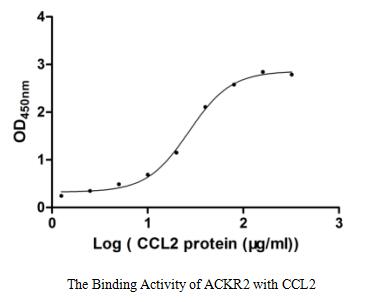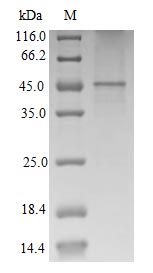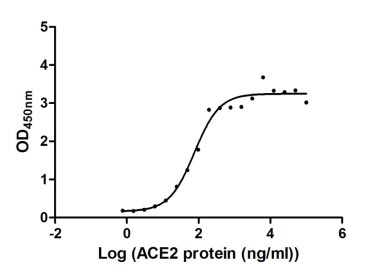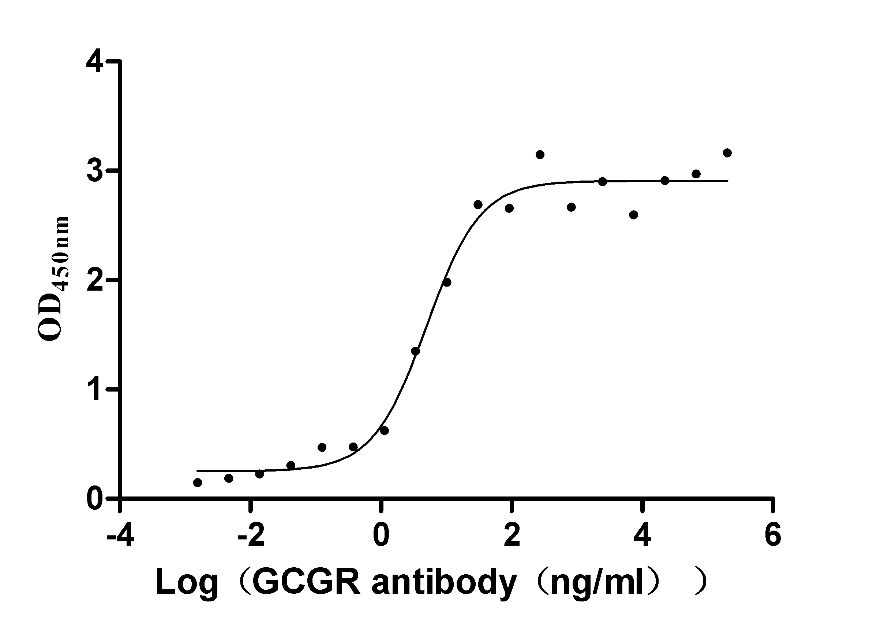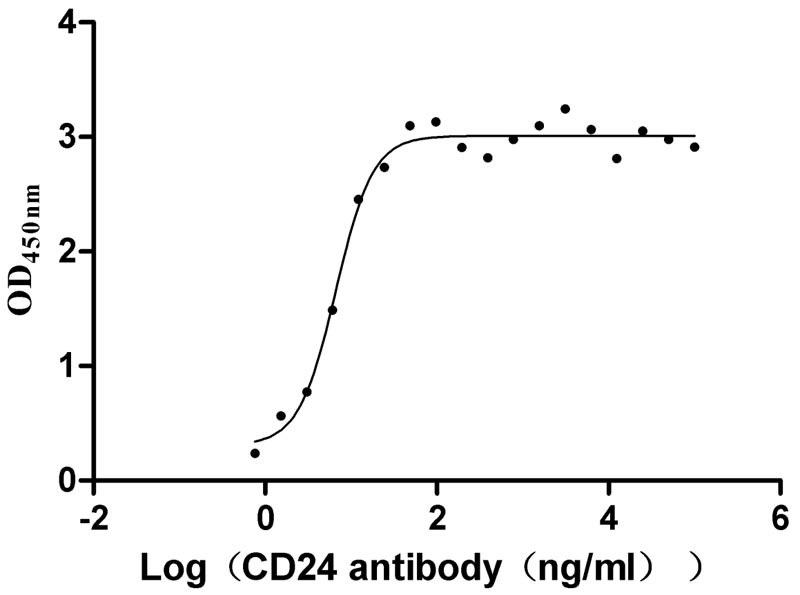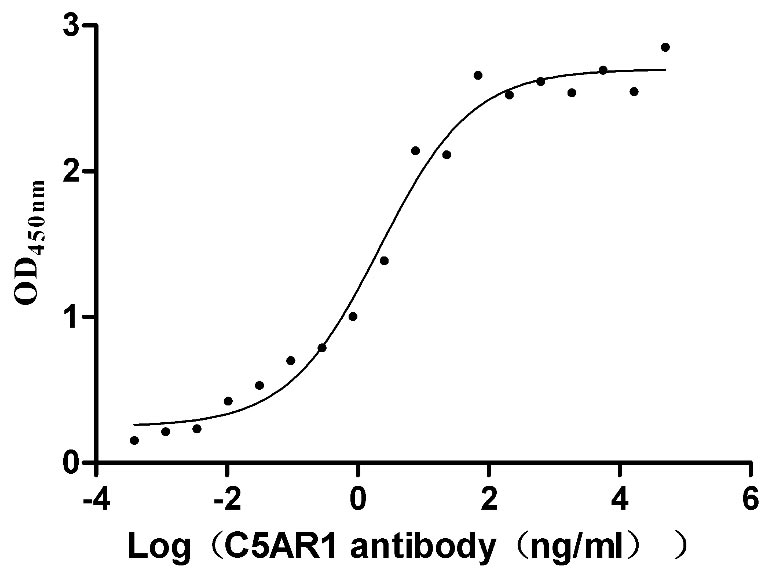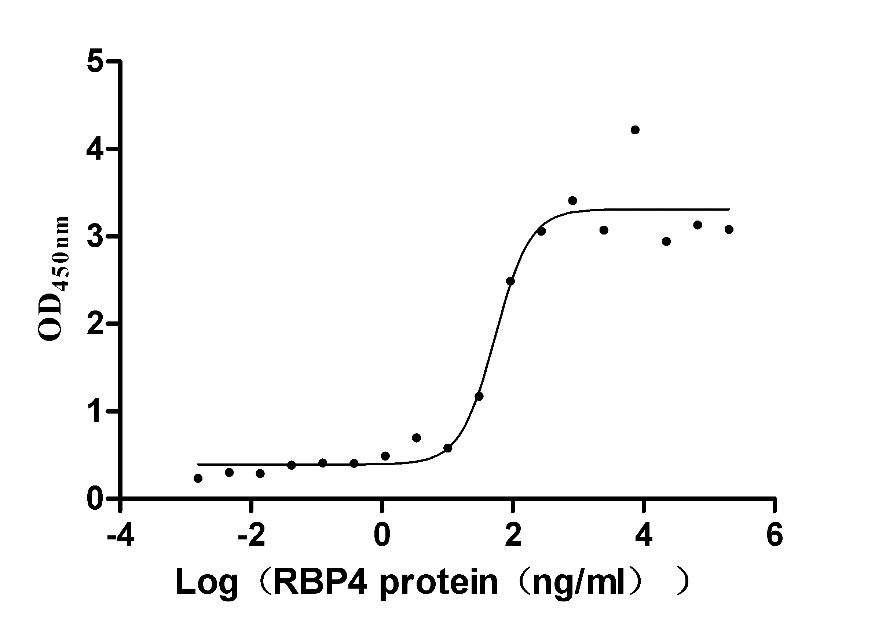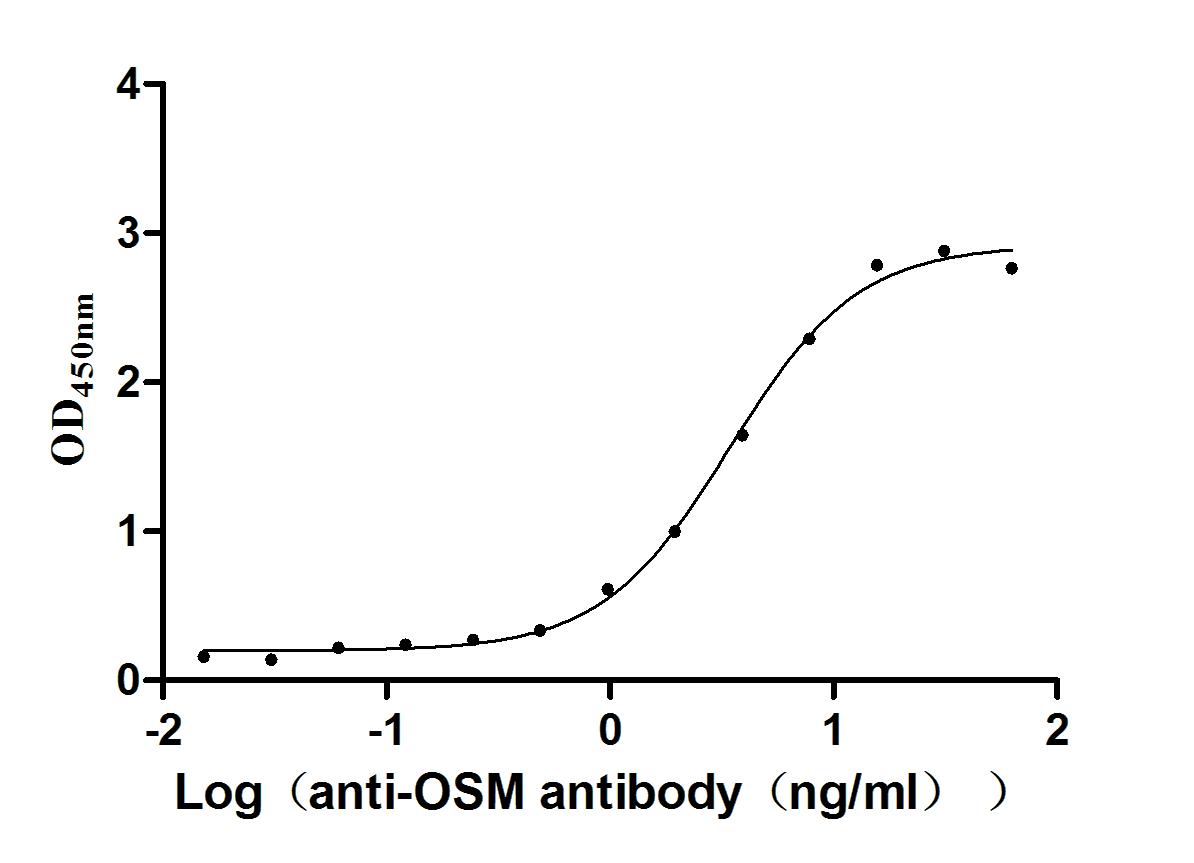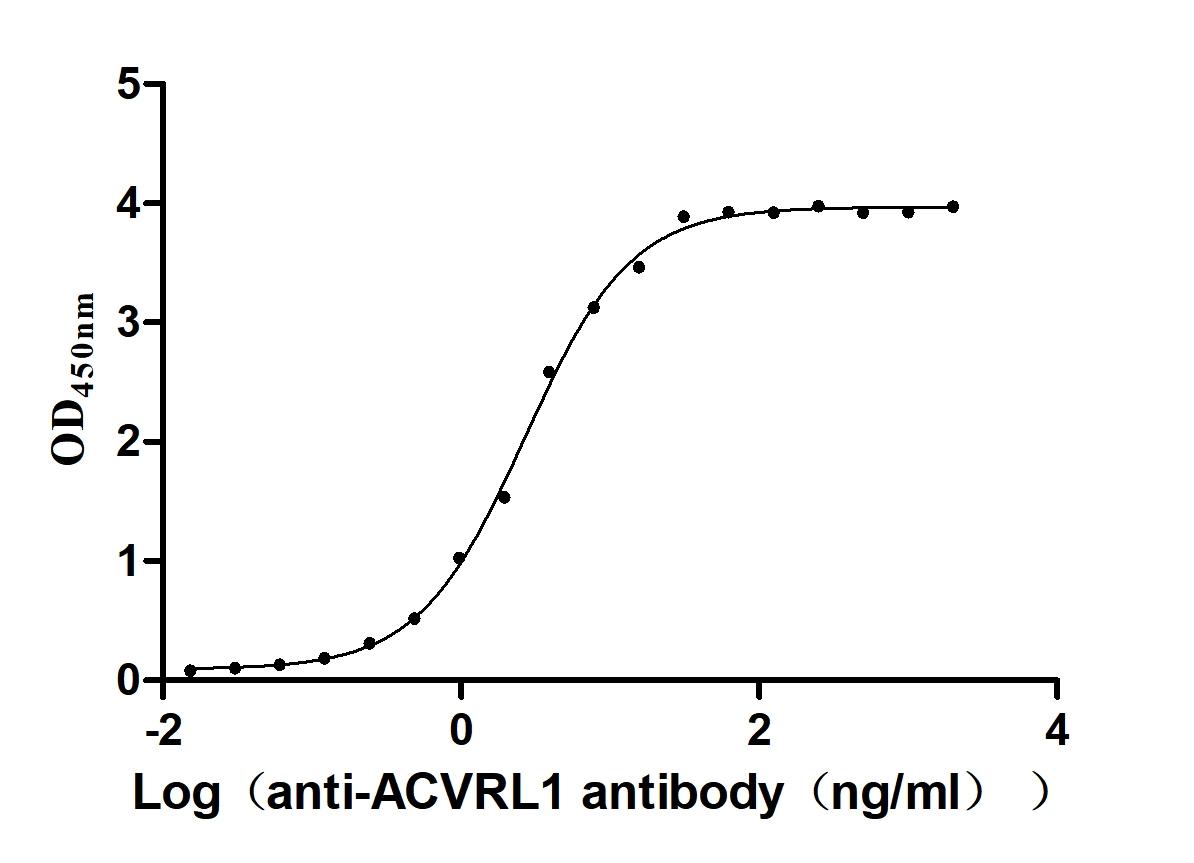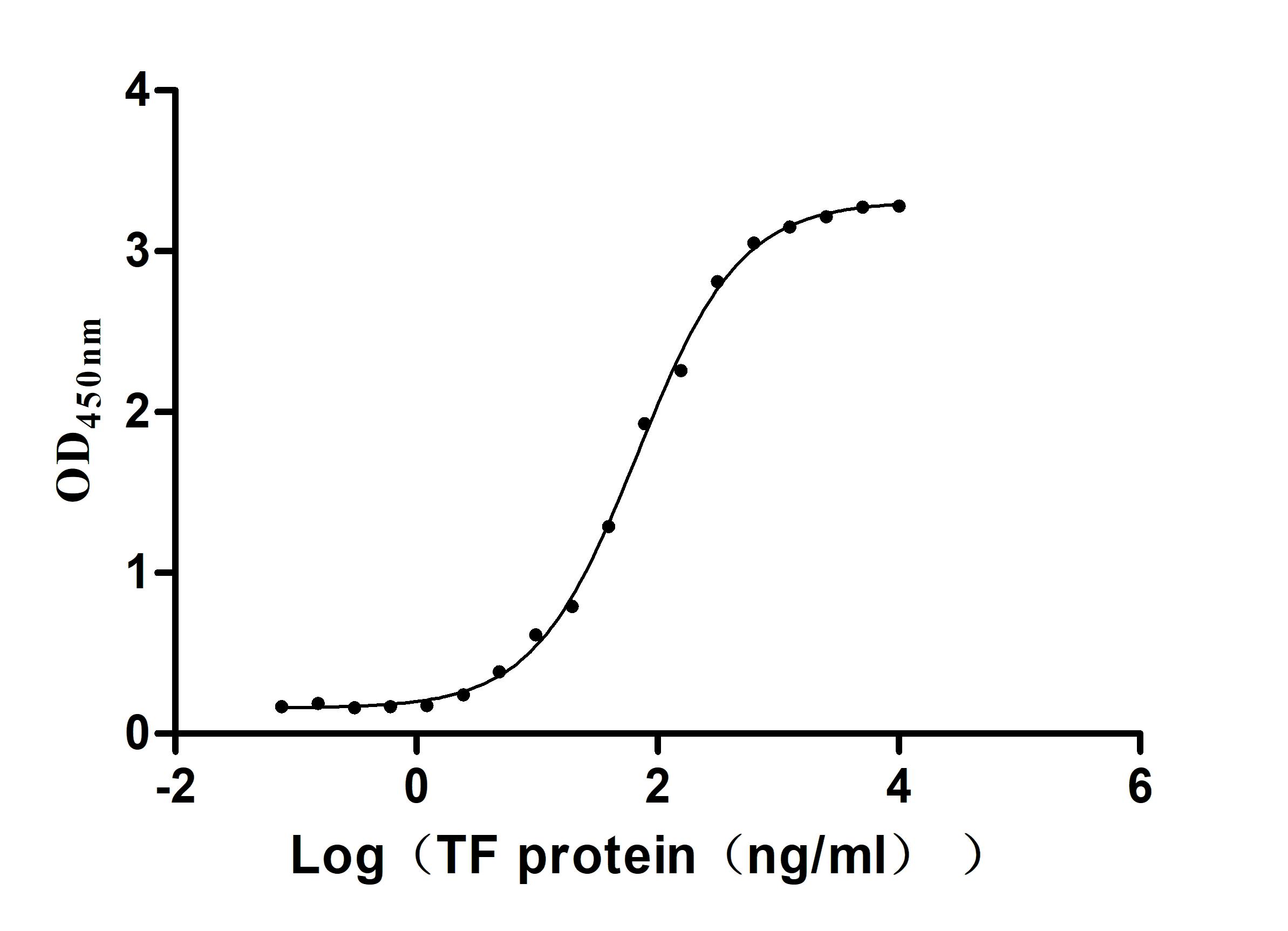Recombinant Human Atypical chemokine receptor 2 (ACKR2) (Active)
-
中文名稱:Recombinant Human Atypical chemokine receptor 2(ACKR2) (Active)
-
貨號:CSB-CF004618HU
-
規格:¥9720
-
圖片:
-
其他:
產品詳情
-
純度:Greater than 85% as determined by SDS-PAGE.
-
生物活性:Measured by its binding ability in a functional ELISA. Immobilized ACKR2 at 1 μg/ml can bind human CCL2, the EC50 of human CCL2 protein is 23.52-30.99 μg/ml.
-
基因名:
-
Uniprot No.:
-
別名:ACKR2; CCBP2; CCR10; CMKBR9; D6; Atypical chemokine receptor 2; C-C chemokine receptor D6; Chemokine receptor CCR-10; Chemokine receptor CCR-9; Chemokine-binding protein 2; Chemokine-binding protein D6
-
種屬:Homo sapiens (Human)
-
蛋白長度:Full Length
-
來源:in vitro E.coli expression system
-
分子量:46.9 kDa
-
表達區域:1-384aa
-
氨基酸序列MAATASPQPLATEDADSENSSFYYYDYLDEVAFMLCRKDAVVSFGKVFLPVFYSLIFVLGLSGNLLLLMVLLRYVPRRRMVEIYLLNLAISNLLFLVTLPFWGISVAWHWVFGSFLCKMVSTLYTINFYSGIFFISCMSLDKYLEIVHAQPYHRLRTRAKSLLLATIVWAVSLAVSIPDMVFVQTHENPKGVWNCHADFGGHGTIWKLFLRFQQNLLGFLLPLLAMIFFYSRIGCVLVRLRPAGQGRALKIAAALVVAFFVLWFPYNLTLFLHTLLDLQVFGNCEVSQHLDYALQVTESIAFLHCCFSPILYAFSSHRFRQYLKAFLAAVLGWHLAPGTAQASLSSCSESSILTAQEEMTGMNDLGERQSENYPNKEDVGNKSA
-
蛋白標簽:N-terminal 10xHis-tagged
-
產品提供形式:Liquid or Lyophilized powder
Note: We will preferentially ship the format that we have in stock, however, if you have any special requirement for the format, please remark your requirement when placing the order, we will prepare according to your demand. -
緩沖液:Tris-based buffer,50% glycerol
-
儲存條件:Store at -20°C/-80°C upon receipt, aliquoting is necessary for mutiple use. Avoid repeated freeze-thaw cycles.
-
保質期:The shelf life is related to many factors, storage state, buffer ingredients, storage temperature and the stability of the protein itself.
Generally, the shelf life of liquid form is 6 months at -20°C/-80°C. The shelf life of lyophilized form is 12 months at -20°C/-80°C. -
貨期:Basically, we can dispatch the products out in 1-3 working days after receiving your orders. Delivery time may differ from different purchasing way or location, please kindly consult your local distributors for specific delivery time.Note: All of our proteins are default shipped with normal blue ice packs, if you request to ship with dry ice, please communicate with us in advance and extra fees will be charged.
-
注意事項:Repeated freezing and thawing is not recommended. Store working aliquots at 4°C for up to one week.
-
Datasheet & COA:Please contact us to get it.
相關產品
靶點詳情
-
功能:Atypical chemokine receptor that controls chemokine levels and localization via high-affinity chemokine binding that is uncoupled from classic ligand-driven signal transduction cascades, resulting instead in chemokine sequestration, degradation, or transcytosis. Also known as interceptor (internalizing receptor) or chemokine-scavenging receptor or chemokine decoy receptor. Acts as a receptor for chemokines including CCL2, CCL3, CCL3L1, CCL4, CCL5, CCL7, CCL8, CCL11, CCL13, CCL17, CCL22, CCL23, CCL24, SCYA2/MCP-1, SCY3/MIP-1-alpha, SCYA5/RANTES and SCYA7/MCP-3. Upon active ligand stimulation, activates a beta-arrestin 1 (ARRB1)-dependent, G protein-independent signaling pathway that results in the phosphorylation of the actin-binding protein cofilin (CFL1) through a RAC1-PAK1-LIMK1 signaling pathway. Activation of this pathway results in up-regulation of ACKR2 from endosomal compartment to cell membrane, increasing its efficiency in chemokine uptake and degradation. By scavenging chemokines in tissues, on the surfaces of lymphatic vessels, and in placenta, plays an essential role in the resolution (termination) of the inflammatory response and in the regulation of adaptive immune responses. Plays a major role in the immune silencing of macrophages during the resolution of inflammation. Acts as a regulator of inflammatory leukocyte interactions with lymphatic endothelial cells (LECs) and is required for immature/mature dendritic cells discrimination by LECs.
-
基因功能參考文獻:
- Data suggest that MIRN146b and MIR10b directly bind 3'-untranslated region of ACKR2 and down-regulate expression of ACKR2 in keratinocytes and in lymphatic endothelial cells, respectively. (ACKR2 = atypical chemokine receptor 2) PMID: 29279330
- ACKR2 is induced after traumatic brain injuries and has a significant impact on mortality and lesion development acutely following closed head injury. PMID: 29176798
- ACKR2 is a molecular regulator play a role in inflammatory changes in patients with psoriasis. PMID: 28010760
- Data indicates that D6 is concentrated on trophoblast cell membranes in pre-eclampsia, in line with higher circulating levels of D6-ligand chemokines, but its scavenging activity is affected by trophoblast cytoskeleton disarrangement. PMID: 27780270
- ACKR2 mediates chemokine scavenging by primary human trophoblasts. PMID: 25297873
- Data show the structural motifs in the atypical chemokine receptor 2 (ACKR2) are responsible for ligand binding, and suggest ACKR2-derived N-terminal peptides as being of potential therapeutic significance. PMID: 24644289
- Data show that low decoy receptor D6 expression correlated to more invasive tumors and that tumor location influences D6 expression, which is lower in the more distal parts of the colon. PMID: 24013383
- engagement of the ACR D6 by its ligands activates a beta-arrestin1-dependent, G protein-independent signaling pathway that results in the phosphorylation of the actin-binding protein cofilin through the Rac1-PAK1-LIMK1 cascade. PMID: 23633677
- co-expression of DARC, D6, and CCX-CKR significantly associated with higher survival in gastric cancer PMID: 23462454
- D6, which is upregulated in both inflammatory and tumor contexts, is an essential regulator of inflammatory leukocyte interactions with lymphatic endothelial cells(LECs) and is required for immature/mature DC discrimination by LECs. PMID: 23479571
- We here summarize the knowledge available today on D6 structural and signaling properties and its essential role for the control of inflammatory cells traffic and proper development of the adaptive immune response. PMID: 22939232
- CCL2 binding to primary adult human astrocytes is CCR2-independent and is likely to be mediated via the D6 decoy. PMID: 22226505
- D6 is expressed in AMs from patients with COPD, and its expression correlates with the degree of functional impairment and markers of immune activation. PMID: 22797410
- These data demonstrate a novel role for D6 as a regulator of the transition from uninvolved to lesional skin in psoriasis. PMID: 22867710
- Chemokine decoy receptor D6 limits CC-chemokine-dependent pathogenic inflammation and is required for adequate cardiac remodeling after myocardial infarction. PMID: 22796582
- DARC and D6, the most studied members of this group of molecules, are reviewed. PMID: 21151196
- Chemokne D6 expression is higher in biopsies taken from more severe cardiac allograft rejection. PMID: 20404785
- D6 protein is found predominantly inside human choriocarcinoma-derived cells with only a small fraction available on the cell surface at any one time, yet it can progressively remove extracellular chemokines, without apparent desensitization. PMID: 20147628
- CCR10 is unlikely to be necessary for cutaneous homing of TH cells in the models studied here. CCR10 may instead play a role in the movement of specialized "effector" cutaneous TH cells to and/or within epidermal microenvironments. PMID: 12406880
- In lymphatic vessels D6 acts as a nonsignaling decoy receptor and scavenger for inflammatory CC chemokines, by clearing them and preventing excessive diffusion via afferent lymphatics to lymph nodes. PMID: 12594248
- CCR10 and its mucosal epithelial ligand CCL28 have roles in the migration of circulating IgA plasmablasts PMID: 12671049
- D6 is constitutively internalized via a ligand-independent, phosphorylation-independent association with beta-arrestin. PMID: 15084596
- We also propose that lymphatic endothelial cell-expressed D6 might have a distinct but complementary role in restricting inflammatory leukocyte access to the lymphatic vasculature. PMID: 16814608
- demonstrate the importance of proinflammatory CC chemokines in de novo tumorigenesis and reveal chemokine sequestration by D6 to be a novel and effective method of tumor suppression PMID: 17607362
- the heptahelical body of D6 on its own can engage the endocytotic machinery of HEK293 cells but that the C terminus is indispensable for scavenging because it prevents initial chemokine engagement of D6 from inhibiting subsequent chemokine uptake. PMID: 18201974
- Emphasis on two new players involved in regulating inflammation at the maternal-fetal interface: the long pentraxin PTX3 and the decoy receptor for inflammatory chemokines D6. PMID: 18676013
- D6 plays a negative role in the growth and metastasis of breast cancer. PMID: 18708360
- D6 expression is GATA1 dependent PMID: 18714007
- Genetic variations are associated with liver inflammation in chronic hepatitis C PMID: 18822328
- Immunohistochemistry on lung lymph nodes from patients with pulmonary tuberculosis showed that D6 expression was prominent in lymphatic endothelial cells, while CD68-positive macrophages did not stain for D6. PMID: 19446728
- D6 cooperates with CD26 in the negative regulation of CCL14 by the selective degradation of its biologically active isoform. PMID: 19632987
顯示更多
收起更多
-
亞細胞定位:Early endosome. Recycling endosome. Cell membrane; Multi-pass membrane protein. Note=Predominantly localizes to endocytic vesicles, and upon stimulation by the ligand is internalized via clathrin-coated pits. Once internalized, the ligand dissociates from the receptor, and is targeted to degradation while the receptor is recycled back to the cell membrane.
-
蛋白家族:G-protein coupled receptor 1 family, Atypical chemokine receptor subfamily
-
組織特異性:Found in endothelial cells lining afferent lymphatics in dermis and lymph nodes. Also found in lymph nodes subcapsular and medullary sinuses, tonsillar lymphatic sinuses and lymphatics in mucosa and submucosa of small and large intestine and appendix. Als
-
數據庫鏈接:
Most popular with customers
-
Recombinant Human Angiotensin-converting enzyme 2 (ACE2), partial (Active)
Express system: Mammalian cell
Species: Homo sapiens (Human)
-
Recombinant Human Glucagon receptor (GCGR), partial (Active)
Express system: Mammalian cell
Species: Homo sapiens (Human)
-
Recombinant Human Signal transducer CD24 (CD24)-Nanoparticle (Active)
Express system: Mammalian cell
Species: Homo sapiens (Human)
-
Recombinant Human C5a anaphylatoxin chemotactic receptor 1 (C5AR1)-VLPs (Active)
Express system: Mammalian cell
Species: Homo sapiens (Human)
-
Recombinant Mouse Retinol-binding protein 4 (Rbp4) (Active)
Express system: Mammalian cell
Species: Mus musculus (Mouse)
-
Recombinant Human Oncostatin-M (OSM), partial (Active)
Express system: Mammalian cell
Species: Homo sapiens (Human)
-
Recombinant Human Serine/threonine-protein kinase receptor R3 (ACVRL1), partial (Active)
Express system: Baculovirus
Species: Homo sapiens (Human)
-
Recombinant Human Serotransferrin(TF) (Active)
Express system: Mammalian cell
Species: Homo sapiens (Human)

